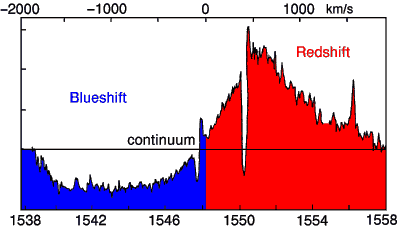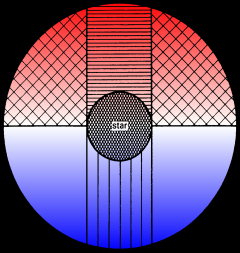


P Cygni emission line profile of triply ionized carbon at 1548.2 Å in the central star of the cat's eye planetary nebula, NGC 6543. Courtesy of the International Ultraviolet Explorer (IUE).
Huggins and Miller were the first to observe the spectra of nova T Coronae Borealis, showing blue-shifted absorption line accompanying each emission line. The nova evolved and they later observed a spectrum characteristic of nebula. These 'P-Cygni' lines are a characteristic common to all novae and stars with strong mass ejections or violent stellar winds such as Eta Carinae. The stellar 'ashes' that accumulate often take the form of a circumstellar nebula of gas and dust.
In the late 19th century, Keeler discovers the unusual emission lines of P-Cygni, a variable star which may have had a novae phase in 1600. It had several bright lines ascribed to helium, and is now classified as a very slow nova.
A quote from C.S.Beals paper on the interpretation of these stars:
 Expanding envelope surrounding stellar surface.
Observer views system from bottom of figure.
Color range from blue for largest blueshift to white for zero Doppler shift
to red for largest redshift. (constantly accelerating radial wind case)
Expanding envelope surrounding stellar surface.
Observer views system from bottom of figure.
Color range from blue for largest blueshift to white for zero Doppler shift
to red for largest redshift. (constantly accelerating radial wind case)For the sake of argument we shall consider a spherically-symmetric optically thin envelope which is radially expanding away from the stellar photosphere.
Because the plasma in the lower region (vertical line pattern) is between the observer and the star, it 'eats' out a blue shifted absorption line from the stellar continuum.
Emission can occur from the whole envelope, however the material in the upper region of the figure (horizontal line pattern) is occulted by the star and cannot be seen by an external observer. This prevents the observer from seeing the maximum of the redshifted emission line component.
The blueward edge of the absorption line often has a much larger absolute Doppler shift than the redward edge of the emission line.
It is from the absorption feature that the maximum expansion velocity is determined.


Surfaces of constant line-of-sight Doppler shift around the star. Colors have same meaning as previous diagram.
Two different cases of radial expansion velocity profiles are shown,

Note how the boundary between the emission and absorption components is rather sharp (Lynds, 1967). The quasar RS 23 also shows three lines with P Cygni profiles (Burbidge, 1970). These spectral signatures of rapid plasma ejection indicate that there is a relationship between quasars and stars with extended atmospheres and strong stellar winds. This has been predicted by Varshni's plasma laser star theory:
Strong laser emission lines is a natural consequence of supersonic plasma ejection rapidly cooled by adiabatic expansion and by contact with colder circumstellar gas and dust. Large amounts of dust naturally collect in the circumstellar shell of laser stars. Some of the dust may reach escape velocity and leave the shell, but this is replaced by condensation from recent plasma ejections. Therefore there should be an ample supply of colder gas and dust to aid in the rapid plasma cooling. This is confirmed by infrared excess observations in many quasars which clearly indicate a dust shell.